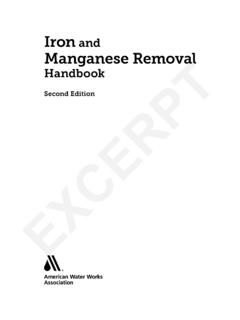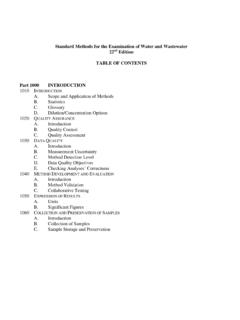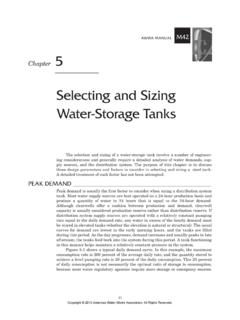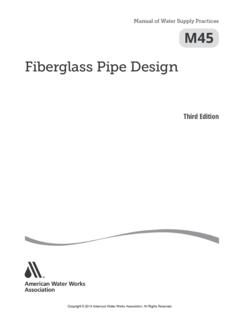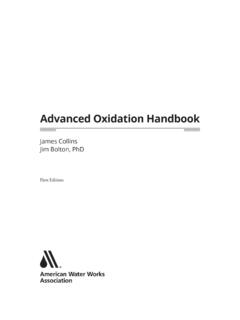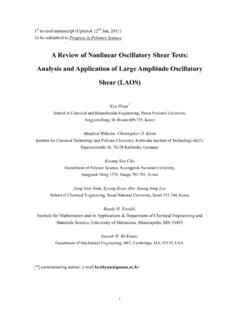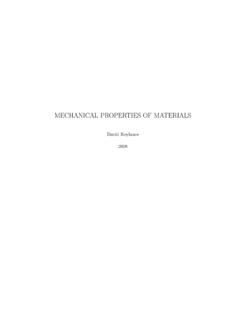Transcription of Engineering Properties of Polyethylene
1 1 AWWA MANUALM55 Chapter1 Engineering Properties of PolyethyleneINTRODUCTIONA fundamental understanding of material characteristics is an inherent part of thedesign process for any piping system. With such an understanding, the pipingdesigner can use the Properties of the material to design for optimum chapter provides basic information that should assist the reader in understandinghow Polyethylene s (PE s) material characteristics influence its Engineering is a thermoplastic, which means that it is a polymeric material that can be soft-ened and formed into useful shapes by the application of heat and pressure and whichhardens when cooled. PE is a member of the polyolefins family, which also includespolypropylene. As a group of materials, the polyolefins generally possess low waterabsorption, moderate to low gas permeability, good toughness and flexibility at lowtemperatures, and a relatively low heat resistance.
2 PE plastics form flexible but toughproducts and possess excellent resistance to many CHARACTERISTICSIn general terms, the performance capability of PE in piping applications is deter-mined by three main parameters: density, molecular weight, and molecular weightdistribution. Each of these polymer Properties has an effect on the physical perfor-mance associated with a specific PE resin. The general effect of variation in thesethree physical Properties as related to polymer performance is shown in Table is a semicrystalline polymer composed of long, chain-like molecules of varyinglengths and numbers of side branches. As the number of side branches increases, poly-mer crystallinity and hence, density decreases because the molecules cannot pack asAWWA Manual M55 Copyright 2005 American Water Works Association. All Rights PIPE DESIGN AND INSTALLATION closely together.
3 Density affects many of the physical Properties associated with theperformance of the finished pipe. Properties such as stress crack resistance, tensilestrength, and stiffness are all affected by the base resin density of the polymer asshown in Table resin density refers to the density of the natural PE that has not been com-pounded with additives and/or colorants. Within this range, the materials are generi-cally referred to as either medium or high density in nature. PE pipe resins with abase resin density in the range of to grams per cubic centimeter (g/cc) arereferred to as medium density PE. PE pipe base resins in the range of to g/ccare commonly referred to as high-density polyethylenes (HDPEs). Industry practicehas shown that base resin (unpigmented) densities in the range of to g/ccoffer a highly beneficial combination of performance Properties for the majority of pip-ing addition of carbon black to the base PE resin does have an impact on the com-pounded density of the material.
4 The addition of 2 to percent carbon black raisesthe compounded material density on the order of g/cc. The variability inthe actual percentage of carbon black incorporated can have a moderate affect on com-parative density values. As a result, industry practice as established by ASTM stan-dard is to provide comparative values on the base resin density as this is a betterindicator of the polymer WeightPE resins are composed of a number of molecular chains of varying lengths. As aresult, the molecular weight of the resin is the average of the weight of each of thesechains. The average weight may be determined using sophisticated scientific tech-niques, such as gel permeation chromatography or size-exclusion chromatography. ForPE of a given density, the effect of increasing molecular weight on physical propertiesis shown in Table very rough indicator of the molecular weight of a polymer may be obtained usingthe melt index technique of analysis as described in ASTM D12381.
5 The melt index tech-nique is an inexpensive means of comparing, in a relative manner, the molecular weightof PEs having similar structure. Resins with a relatively low average molecularTable 1-1 Effects of density, molecular weight, and molecular weight distributionPropertyAs Density IncreasesAs Molecular Weight IncreasesAs Molecular Weight Distribution BroadensTensileIncreasesIncreases StiffnessIncreasesIncreases slightlyDecreasesImpact strengthDecreasesIncreasesDecreasesLow temperature brittlenessIncreasesDecreasesDecreasesAb rasion resistanceIncreasesIncreases HardnessIncreasesIncreases slightly Softening pointIncreases IncreasesStress crack resistanceDecreasesIncreasesIncreasesPer meabilityDecreasesIncreases slightly Chemical resistanceIncreasesIncreases Melt strength IncreasesIncreasesAWWA Manual M55 Copyright 2005 American Water Works Association. All Rights Properties OF POLYETHYLENE3weight will have a comparatively high melt index.
6 Conversely, resins with a relativelyhigh molecular weight will yield a lower melt index. From this relationship, we canassociate changes in physical Properties (as shown in Table 1-1) with changes in meltindex of the material. It is important not to use melt index alone as a definitive indicatorof molecular weight because variations in polymer structure can affect both molecularweight and melt Weight DistributionMolecular weight distribution (MWD) refers to the statistical grouping of the individ-ual molecular chains within a PE resin. Resins made up of molecules that vary consid-erably in molecular weight are considered to have a broad MWD. When most of themolecules are nearly the same length, the MWD is considered narrow. The effect ofbroadening the MWD of a PE resin having a given density and molecular weight isshown in Table AdvancesIt should be noted that recent advances in polymer technology have led to the develop-ment and introduction of even higher density resins for use in piping new materials that have base resin densities as high as g/cc in combina-tion with higher molecular weight and bimodal molecular weight distribution are gen-erally recognized as offering higher levels of technical performance under ISOstandards for PE piping that are common outside of North America.
7 These higher lev-els of technical performance are not yet recognized within the North American stan-dards PROPERTIESV iscoelasticityPE is characterized as a viscoelastic construction material. Because of its molecularnature, PE is a complex combination of elastic-like and fluid-like elements. As aresult, this material displays Properties that are intermediate to crystalline metalsand very high viscosity fluids. Figure 1-1 is the traditional diagrammatic representa-tion of PE in which the springs represent those components of the PE matrix thatrespond to loading in a traditional elastic manner in accordance with Hooke s law. Thedashpots represent fluid elements of the polymer that respond to load much as a New-tonian a result of the viscoelastic character of the polymer, the tensile stress straincurve for PE is divided into three distinct regions.
8 The first of these is an initial lineardeformation in response to the load imposed that is generally recoverable when theload is removed. In the second stage of loading, deformation continues but at an everdecreasing rate. Thus, the slope of the stress strain curve is constantly changing,attesting to its curvilinear nature. Deformation in the second stage may not be fullyrecoverable. The final stage of the stress strain curve for PE is characterized by neck-ing down followed by distinct elongation or extension ultimately ending in ductile rup-ture of the viscoelastic nature of PE provides for two unique Engineering characteristicsthat are employed in the design of HDPE water piping systems. These are creep andstress Manual M55 Copyright 2005 American Water Works Association. All Rights PIPE DESIGN AND INSTALLATIONC reep is not an Engineering concern as it relates to PE piping materials.
9 Creeprefers to the response of PE, over time, to a constant static load. When HDPE is sub-jected to a constant static load, it deforms immediately to a strain predicted by thestress strain modulus determined from the tensile stress strain curve. The materialcontinues to deform indefinitely at an ever decreasing rate. If the load is high enough,the material may yield or rupture. This time-dependent viscous flow component ofdeformation is called creep. This asserts that the long-term Properties of PE are notadequately predicted by the results of short-term testing, such as tensile strength. Assuch, PE piping materials are designed in accordance with longer-term tests such ashydrostatic testing and testing for resistance to slow crack growth, which when usedin accordance with industry recommended practice, the resultant deformation causedby sustained loading, or creep, is not sufficiently large to be an Engineering relaxation is another unique property arising from the viscoelastic nature ofPE.
10 When subjected to a constant strain (deformation of a specific degree) that ismaintained over time, the load or stress generated by the deformation slowlydecreases over time. This is of considerable importance to the design of PE of its viscoelastic nature, the response of PE piping systems to loading istime-dependent. The effective modulus of elasticity is significantly reduced by theduration of the loading because of the creep and stress relaxation characteristics ofPE. An instantaneous modulus for sudden events such as water hammer can be ashigh as 150,000 psi at 73 F (23 C). For slightly longer duration, but short-term eventssuch as soil settlement and live loadings, the effective modulus for PE is roughly110,000 to 120,000 psi at 73 F (23 C), and as a long-term property, the effective long-term modulus calculates to be approximately 20,000 to 38,000 psi.
